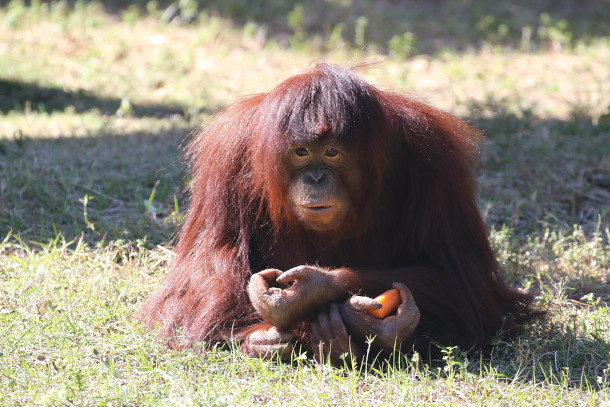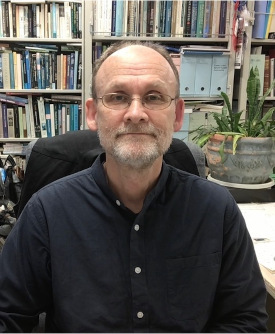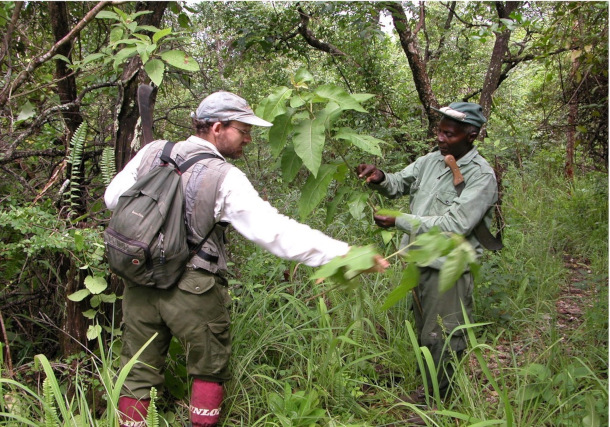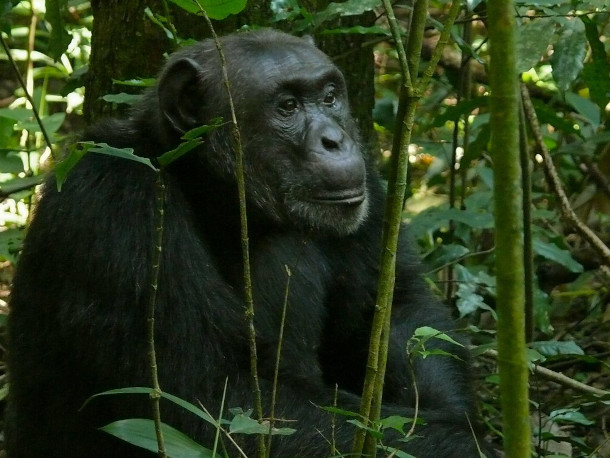Animal Self-Medication
Air Date: Week of May 17, 2024

Sumatran orangutans are an endangered species native to Indonesia. (Photo: cuatrok77, Flickr, CC BY-NC-SA 2.0)
A paper published in the journal Scientific Reports describes the case study of an orangutan who treated and healed his own wound. Zoologists have long seen behaviors of self-medicating in the animal kingdom, but until now it has rarely if ever been documented in scientific literature. Michael Huffman, an ecologist who reviewed the paper joined Living on Earth’s Paloma Beltran to discuss how some animals are known heal themselves.
Transcript
O’NEILL: It’s Living on Earth. I’m Aynsley O’Neill.
BELTRAN: And I’m Paloma Beltran.
Much of humanity’s medicine has its roots in the natural world around us. Think about asprin, whose main ingredient can also be found in plants like willow and myrtle. Or for something a little stronger, opiates, which are synthesized from the flowers of the poppy plant. But humans aren’t the only creatures who have used plant medicine: zoologists have long seen behaviors of self-medicating in the animal kingdom. And recently, a paper was published in the journal Scientific Reports that describes the case study of an orangutan who healed his own wound. Rakus is a male, Sumatran orangutan living in Indonesia. After he sustained an injury to his face, Rakus chewed up the leaves of a woody vine called Akar Kuning. He then applied both the juice and the leaves of the plant to his face. Within five days, the wound closed. Here to talk to us about this discovery is Michael Huffman, an ecologist who has spent his career studying the ways animals self-medicate. While he isn’t an author of the paper, he was one of the reviewers prior to publication. Michael Huffman, welcome to Living on Earth!
HUFFMAN: Thanks. Nice to be here.
BELTRAN: What makes this discovery new and exciting?
HUFFMAN: Well, it's the first detailed observation of an animal taking a plant and putting it onto a wound. And that wound apparently healed in a relatively good period of time. But the fact that the male put a plant with medicinal properties on a wound, very concertedly, it couldn't be mistaken as just an accident, is very interesting. There have been many reports unpublished and unscientific about this type of thing in other animal species. So to have this detailed observation and have it published is very important, because it'll wake up scientists in the field to keep an eye on this kind of behavior, because there are previous examples of something like this happening in other species, but we didn't have the details that this paper has provided.
BELTRAN: So the plant that the orangutan named Rakus used to self-medicate is called Akar Kuning. What do we know about this plant?
HUFFMAN: The scientific name, the Latin name is Fibraurea tinctoria. And it seems to be widely used in Asia, Southeast Asia as medicine. It has anti-inflammatory properties. It has antimicrobial, probably antibiotic properties, as well, and people use it widely. Another interesting thing, the researchers in this team and those from other groups who have been working at this site for a very long time, had never seen that behavior before, and Rakus the male came in from an outside population as male orangutans do, they lead the group that they're born into, and they, they tend to travel around fairly solitarily and try and establish a territory, so he may be introducing a new behavior into this population that will allow these orangutan, if the behavior is transmitted to others, to treat wounds, which can be a serious problem, especially in the tropics. Wounds are hard to heal. They tend to ulcerate and early treatment and keeping it clean is very important. Animals have an amazing way of healing themselves to begin with, they have a strong immune system. But as we know from other types of self-medication, they also need plants and things to help that process along.
BELTRAN: And from what I understand primates are not the only animals who self-medicate. Tell us more about that.
HUFFMAN: To make a long story short, every animal on the planet self-medicates. We have observations and detailed studies from everything, including ants and bees, all the way up to humans who also self-medicate. Before modern medicine, all the treatments were happening in the home. People were going out into the forest finding a plant that they had learned from their elders were effective in treating a number of different symptoms. So every species of animal on the planet gets sick, are affected by parasites or microbes or some other type of disease. We have accidents. We fall. We get cut. So every species on the planet self-medicates.
BELTRAN: If such a broad range of species do this, then they probably have many different approaches. What are some other ways that animals self-medicate?
HUFFMAN: The patterns seem to be very similar across different species. Two of the modes that I have been working on in various different species, not all primates, is that in the normal diet, they include things that we would consider things like, spices, chilies, gingers, things like that. Onions even have antibacterial properties. So they keep the food from spoiling, they keep down the microorganisms that can give us an upset stomach, for example. Another example that I found really, really interesting is called leaf swallowing. And plants have a self-defense mechanism to prevent animals from over eating their plant bodies. And so they transfer toxic compounds to the leaves or they'll set up barriers like very small hairs and things that are very hard to digest. And if an animal eats too many of these leaves, then it gets indigestion. So they tend to avoid certain leaves of certain species because of those properties that the plant uses. But some animals have found a way to use that to their benefit, and they'll fold and swallow these leaves that are hard to digest. And what that does is reduces the time that it takes for food to pass through the system. And normally it's up to 24 hours, 30 hours, maybe but what a number of different species, African great apes included, will do is fold and swallow leaves, reducing that transit time to six hours, and they're expelling the parasites in their intestinal tract. So they have a physical means of purging themselves of parasites. So it's a cool way of keeping the system clean. And we have examples of this in birds, in bears, in several primate species. It's really an interesting way of controlling parasites.

Dr. Michael Huffman has spent the majority of his career studying self-medication in animals. (Photo: Courtesy of Michael Huffman)
BELTRAN: Professor, you've spent most of your career studying this topic. What got you interested in the subject?
HUFFMAN: I first stumbled upon self-medication in animals following chimpanzees in Tanzania in the Mahalia mountains. It was not my research topic. But I was always interested in medicinal plants and how traditional cultures around the world use those plants. And I had the good fortune of working with Mohamedi Seifu Kalunde. He was one of the staff in our research project that had been ongoing since 1965. And I started studying chimps in 1985. And I would often walk with him in the forest. And when we couldn't find the chimps, he would teach me about plants that his family had learned about and used to treat other people in the village. We worked together for probably close to 20 years. And it was the second year into my research there and working with him that we came across a chimpanzee named Chausiku. She did something very interesting. I hadn't seen chimps eat a certain plant until that day, and it was Chausiku, who was doing it. And I asked Mohamedi, what's the name of the plant and he told me, it's Majonso. And I had never heard of that name. Tell me more about the plant. But I was interested in what, how she was going to eat it. So I was just watching as Chausiku took this plant and she peeled off the bark and started chewing on the pit. Very, very fresh, like celery. So she was chewing, and then she sucked out the juice, but spit out everything else. Mohamedi breaks in and says, "Yeah, it's very, very bitter. I don't know why chimpanzees would want to eat this very bitter plant. We use it as medicine." And I began to remember that earlier that day, she wasn't well, and she climbed up a tree, built a nest and went to sleep. But she left her young infant Chopin just running around doing his thing. First thing that Chausiku did was to go to this plant Vernonia amygdalina. So we were able to understand during the observations of two days, that she was very sick the first day, really not well the next morning, but by the next noon time, her behavior changed completely. Her appetite came back. Her strength came back. So just those two days was the beginning of a 35-year study on how animals self-medicate, and it continues today.
Nature is so cool! And we have no idea!
— 360 on History (@360onHistory) May 12, 2024
Rakus the orangutan patched a wound on his face up with a #medicinalplant - a first ever recorded instance of an animal self-medicating! #NatureIsAmazing #Intelligence #nature #animals #medicine https://t.co/OTnHv3g0Tg
BELTRAN: Although science has only somewhat recently acknowledged self-medicating animals, indigenous communities have known about this phenomenon for 1000s of years. Can you talk a little bit about that?
HUFFMAN: As I mentioned before, with working with Mohamedi, we worked for about 20 years together, and it was only around the seventh, eighth or ninth year of our collaboration deep into studying animal self medication in chimps that one day when the chimps were way, way up in the mountains, we were waiting for them to come down. And then he said, "I have a story for you about a plant that my grandfather discovered by watching a sick porcupine." And he went to tell me about how his, his grandfather, Babu Kalunde, discovered a very strong antibiotic by watching a porcupine dig up the roots and treat itself for bloody stools. And I said, "Well, that, that's amazing." And he says, "Yeah. And we have other examples." And I go, "What? You mean, your family and your tribe know that animals self-medicate? They've been aware of this for a long time?" "Oh, yeah, we have many examples like this." So I got really interested, and I started looking at the literature from around the world. And it turns out that almost every society that I've been able to read about or talk with people from that culture, there is at least one plant that they have learned from animals.

Dr. Huffman worked closely with Mohamedi Seifu Kalunde in Tanzania to learn more about the medicinal properties of native plants. (Photo: Courtesy of Michael Huffman)
BELTRAN: And what are your hopes for the future of this research?
HUFFMAN: Well, I hope more and more people will come on board and start looking carefully at their study subjects. Look at new species, we know very little about how animals in the ocean self-medicate. There's a lot of plants in the ocean that have toxic properties. Just like plants on land, they produce these things to protect themselves. But I'm sure that, that animals have also learned that those substances can be of benefit. So that may be one of our final frontiers, as it were, to go to the ocean and see how animals in the sea are dealing with diseases. But there's still so much on land in all the different habitats that animals live in that we really need to look at more. And I think in the end, the more we appreciate how animals exist in their environment, how they've acquired all of this knowledge and how it's maintained within these different societies of animals, different cultures of animals, we'll come to appreciate them more and take better care of the planet. I don't know who said this, but it is so true. Nature doesn't need us. We need nature. So I think we have to take better care of the nature around us and pay a little bit more respect to the animals who are living there.

Although it is likely that many of the animal species on the planet self-medicate, scientists most often identify the behavior in primates, like chimpanzees. (Photo: Bernard Dupont, Flickr, CC BY-NC-SA 2.0)
BELTRAN: Dr. Michael Huffman is a visiting professor at the Institute of Tropical Medicine at Nagasaki University. Thank you for joining us.
HUFFMAN: Thank you.
Links
Living on Earth wants to hear from you!
Living on Earth
62 Calef Highway, Suite 212
Lee, NH 03861
Telephone: 617-287-4121
E-mail: comments@loe.org
Newsletter [Click here]
Donate to Living on Earth!
Living on Earth is an independent media program and relies entirely on contributions from listeners and institutions supporting public service. Please donate now to preserve an independent environmental voice.
NewsletterLiving on Earth offers a weekly delivery of the show's rundown to your mailbox. Sign up for our newsletter today!
 Sailors For The Sea: Be the change you want to sea.
Sailors For The Sea: Be the change you want to sea.
 The Grantham Foundation for the Protection of the Environment: Committed to protecting and improving the health of the global environment.
The Grantham Foundation for the Protection of the Environment: Committed to protecting and improving the health of the global environment.
 Contribute to Living on Earth and receive, as our gift to you, an archival print of one of Mark Seth Lender's extraordinary wildlife photographs. Follow the link to see Mark's current collection of photographs.
Contribute to Living on Earth and receive, as our gift to you, an archival print of one of Mark Seth Lender's extraordinary wildlife photographs. Follow the link to see Mark's current collection of photographs.
 Buy a signed copy of Mark Seth Lender's book Smeagull the Seagull & support Living on Earth
Buy a signed copy of Mark Seth Lender's book Smeagull the Seagull & support Living on Earth

